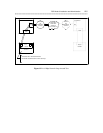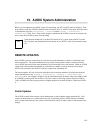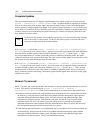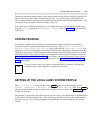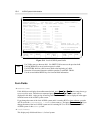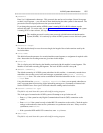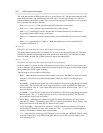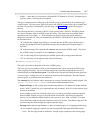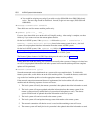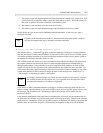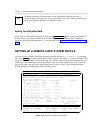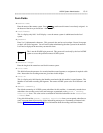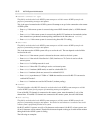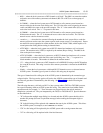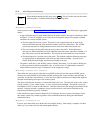AUDIX System Administration 13-7
_ ______________________________________________________________________________________
_ ______________________________________________________________________________________
_ ______________________________________________________________________________________
— (blank) — where the local system uses a dedicated RS-232 channel to call itself. If another type of
system is called, a dial string may be required.
The type of channel used for calling out of the AUDIX system is determined by the connection type
assigned earlier. The loop used to get the call back to the AUDIX system and the type of channel used
once the call gets there is determined by the dial string. See Chapter 14 for details on testing the
network.
The following characters, valid only in R1V5 or later systems when a TN539 or TN539B is present,
have special meaning within an AUDIX system dial string. They must be enclosed within double
quotation marks, for example, "x". These characters are not passed on to the switch, modem, or
endpoint in a network call. They are interpreted by the TN539 or TN539B ACCE. Special characters
are described below:
— "W" indicates that multiple-stage dialing is to be used and that AUDIX system should wait for
another dial prompt (dial tone or equivalent message) before sending the subsequent digits or
characters.
— "B" in the dial string will be replaced with a BREAK character by the AUDIX system. This allows
the AUDIX system, for example, to send a BREAK to a modem.
— "CR" in a dial string will be replaced by the AUDIX system with a carriage return character.
— "LF" in a dial string will be replaced with a line feed character.
• address ranges/warnings
The prefix is not used on the profile of the local AUDIX system.
The start/ end extension defines a block of switch extensions that can be used at the AUDIX system
when assigning subscribers. Up to ten different ranges can be specified to pinpoint the exact set of
extension blocks used by the local system. The length of the start and end extensions must agree with
extension length. Leading zeros may be required to conform to this requirement. The end extension
must be equal to or greater than the start extension.
The warnings field will indicate when a duplication or overlap of another range is being assigned. The
system : translation : address form shows extension numbers in use.
— Duplicate Range (or full overlap) means that the range defined is also defined for another machine
profile. In R1V3 and R1V4, up to eight duplicates may be defined. In R1V5 or later software, up to
sixteen can be defined.
As an example, say that two colocated systems serve a scattering of different extensions between
2000 and 6999. Instead of trying to pin-point blocks of extensions, which may be impossible
anyway, you can define the address range for both systems as start: 2000, end: 6999. A location
across the country might use the same extensions as the local location. The address range(s) for the
system serving that location might also require duplicate ranges.
— Overlaps means that the range defined is a subset of another range or is overlapping another range:
• You would be assigning a subset if you tried to assign 2000-3999 when 2000-5999 already
exists. The new range would be disallowed. Instead, assign a duplicate of the existing range.



